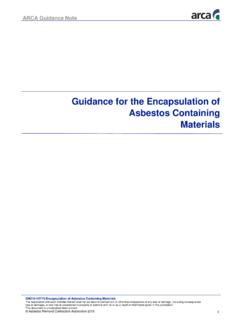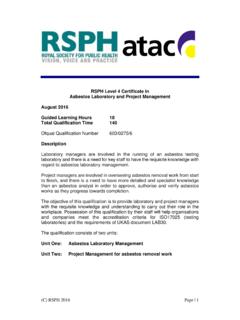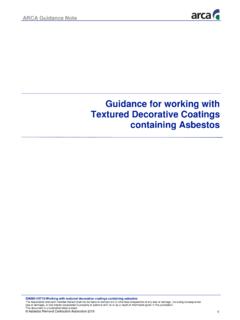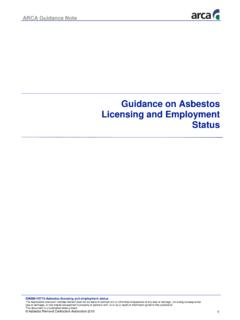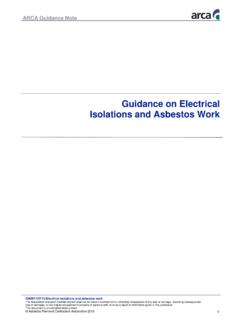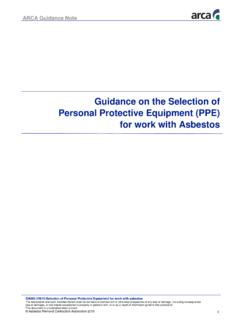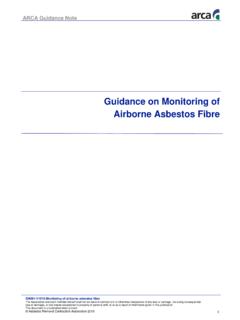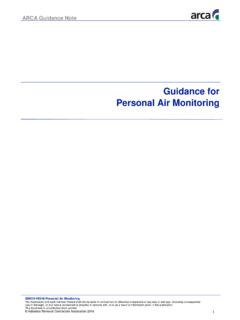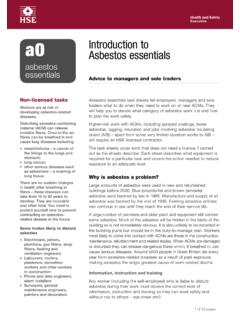Transcription of Guidance on Air Management in Asbestos Enclosures
1 ARCA Guidance Note Guidance on Air Management in Asbestos Enclosures GN006-V0715-Air Management in Asbestos Enclosures The Association and each member thereof shall not be liable in contract tort or otherwise irrespective of any loss or damage, (including consequential loss or damage), or any nature occasioned to property or persons with, to or as a result of information given in this publication. This document is uncontrolled when printed. Asbestos Removal Contractors Association 2015 1. ARCA Guidance Note Guidance ON AIR Management IN Asbestos Enclosures . 1. BACKGROUND. This Guidance note is intended to clarify expectations with regard to air Management , following recent industry research and the subsequent changes to the Approved Code of Practice.
2 This note gives an overview of the general principles involved in air movement within Enclosures as it is now understood. For more detail, please see the sources of further information listed in section 5. Recent research provides a better understanding of air movement in Enclosures and shows the limitations of the previous approach described in the Licensed Contractors' Guide (HSG247, published 2006). It is ARCA's understanding that the recent research will be reflected in HSE's approach to inspecting air Management issues; enforcement action may be taken where licensed contractors cannot demonstrate that reasonable efforts have been made to manage airflow inside Enclosures . Updated Guidance will take the findings of latest research into account.
3 The term air changes per hour' is used in the Guidance and ACoP. It is used to make a simple comparison between the volume of the enclosure and the volume of air being moved by NPUs. However, drawing 1000m3/hour of air through a 1000m3 space for an hour will not provide one complete air change, due to the effect of turbulence and persistent stratification within the enclosure . The previous approach to air Management may result in Enclosures without suitable negative pressure and with persistent stratification' caused by insufficient air mixing. 2. CONTROL OF Asbestos REGULATIONS 2012 AND APPROVED CODE OF. PRACTICE (CAR & ACoP). Regulation 16 requires employers to prevent the spread of Asbestos fibres, so far as is reasonably practicable and to reduce spread to the lowest level reasonably practicable, where prevention is not possible.
4 Enclosures under negative pressure are intended to prevent spread and paragraph 389 of the ACoP now specifies a minimum airflow of 1000m3/hour through small Enclosures (<120m3), and at least 8 air changes per hour in larger Enclosures . 3. PRACTICAL Guidance . The specified level of air movement (air flow of 1000m3/hour for small Enclosures and at least 8 air changes for larger Enclosures ) has been shown to be the most reliable factor for good air Management . Where this level of air movement is achieved, there is expected to be: Negative pressure of c. -5pa (good containment). Thorough air mixing in the enclosure (reducing exposure and spread). GN006-V0715-Air Management in Asbestos Enclosures The Association and each member thereof shall not be liable in contract tort or otherwise irrespective of any loss or damage, (including consequential loss or damage), or any nature occasioned to property or persons with, to or as a result of information given in this publication.
5 This document is uncontrolled when printed. Asbestos Removal Contractors Association 2015 2. ARCA Guidance Note There will also be an easy method for determining correct air flow, by using air lock door flaps as an indicator. Standard' flaps show a deflection of around for each 1m3/hour of air flow ( around 200mm at 1000m3/hour), regardless of enclosure size. Terms & definitions - for the purposes of this Guidance note: Standard' air locks are the minimum' 1x1x2m stages. Where space allows, larger stages should always be provided to make decontamination easier. Air locks (flap weight and size) The width and weight of the flaps are significant: wider, heavier flaps will offer more resistance to air.
6 For the purposes of this note, standard flaps' are wide and are weighted by rolling up excess 1000-gauge polythene sheeting (approximately 400g). Extra air inlets all air movement is expected to be carefully planned and managed. Where extra air intake is needed, this should normally be achieved by providing additional air chambers'. For ease of Management , licence holders should build air chambers to a uniform shape: a single stage air lock of 1x1x2m. They must be clearly marked with appropriate signage and fitted with barriers (netting, tape etc.) to prevent staff access. GN006-V0715-Air Management in Asbestos Enclosures The Association and each member thereof shall not be liable in contract tort or otherwise irrespective of any loss or damage, (including consequential loss or damage), or any nature occasioned to property or persons with, to or as a result of information given in this publication.
7 This document is uncontrolled when printed. Asbestos Removal Contractors Association 2015 3. ARCA Guidance Note KEY POINTS. AIR IN = AIR OUT Where Enclosures are perfectly sealed, the volume of air pulled out must be equal to the volume of air allowed in. In other words, where 3. an enclosure has a series of NPUs intended to move 10,000m /hour 3. of air, it must be designed to allow 10,000m /hour in. AIR LOCKS HAVE 3. 1000m /hour of air flow through an air lock will deflect a standard'. 3. LIMITS door flap around 200mm. At 1500m /hour, the amount of deflection (c. 300mm) starts to restrict the space available for decontamination 3. in the minimum' 1m square stage (at 5000m /hour, the flaps would be hitting the next chamber of standard' airlock configuration).
8 Where larger volumes of air are required, further air chambers should be planned and managed on site. GUIDELINE LIMITS. 3. * standard' air lock or bag lock = 1500m /hour each 3. * standard' additional air chamber = 5000m /hour. NPUs & ACTUAL Good air Management planning requires knowledge of the actual air PERFORMANCE flow achieved by an NPU. Site teams should establish actual flow during set up, using an anemometer and mark the air lock to show flap deflection with this amount of airflow. During the works, the flap deflection can be used as a reference point. For planning purposes, NPUs should be referred to by their last known actual rating rather than (nominal) manufacturer's rating. Standard units of measurements should be used throughout the 3.
9 Organisation: m /hour. Variable speed controls may be of significant benefit, enabling larger units to be turned down' if necessary. These can be retrofitted for between 60 and 100. DUCTING & The effect of ducting can be significant. As a rule of thumb ducting ELECTRICAL SUPPLY (either side of the NPU) is likely to reduce flow by 1% for each metre and by 2% for each bend. The quality of electrical supply (including length of cable runs) can have a significant impact on an NPU's actual site performance. VARIABILITY There are a number of variables in any enclosure system: for example, flap width and weight will have an impact on the amount of deflection seen. Mark the side of the airlock to show the amount of flap deflection for the level of actual airflow through the enclosure , as designed.
10 Comparing amount of deflection against this mark during the project will be a good indicator of performance. Where variable speed NPUs are in use, the setting on the NPU. should also be clearly marked and monitored. GN006-V0715-Air Management in Asbestos Enclosures The Association and each member thereof shall not be liable in contract tort or otherwise irrespective of any loss or damage, (including consequential loss or damage), or any nature occasioned to property or persons with, to or as a result of information given in this publication. This document is uncontrolled when printed. Asbestos Removal Contractors Association 2015 4. ARCA Guidance Note Sample workplace scenarios Large' enclosure dimensions approximately 20m x20m x 3m = 1200m3.
